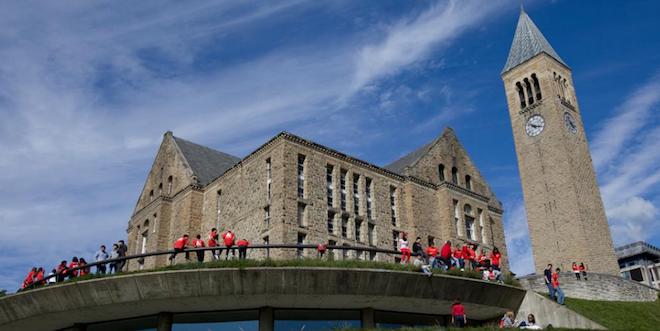
Cornell’s Dyson School was by far the most exclusive in the U.S. this year, with an acceptance rate of just 2.93%
Lynn Wooten was senior associate dean for student and academic excellence at the University of Michigan’s Ross School of Business when that school expanded its undergraduate program from three to four years, after being a two-year program until 2005. Wooten told Poets&Quants last year that the two-year program was modeled after an MBA. The only problem? A BBA, Wooten stressed, is not an MBA. “The undergraduate business school experience is very different,” Wooten said. “You’re helping to shape someone’s transition from adolescence to adulthood.”
 Wooten is now facilitating that transition at a different school — one that is even more selective than her previous employer. In her first semester as dean of the Charles H. Dyson School of Applied Economics and Management, she has seen the Dyson School’s acceptance rate plunge from an already stingy 7% last year to an outright miserly 2.93%, by far the lowest of any of the schools in the second annual Poets&Quants undergraduate business school ranking. Cornell Dyson had 128 admits in the fall of 2017 out of 4,366 applicants.
Wooten is now facilitating that transition at a different school — one that is even more selective than her previous employer. In her first semester as dean of the Charles H. Dyson School of Applied Economics and Management, she has seen the Dyson School’s acceptance rate plunge from an already stingy 7% last year to an outright miserly 2.93%, by far the lowest of any of the schools in the second annual Poets&Quants undergraduate business school ranking. Cornell Dyson had 128 admits in the fall of 2017 out of 4,366 applicants.
“That number is correlated to our expansion as part of the Johnson College of Business,” Wooten tells P&Q, noting that on July 1, 2016, Cornell University launched a new college uniting the university’s three AACSB-accredited business schools: The Hotel School, the Dyson School, and the Samuel Curtis Johnson Graduate School of Management — and that less than seven months later, Trustee Emeritus H. Fisk Johnson committed $150 million to endow the newly named Cornell SC Johnson College of Business. “Once we actually became part of the College of Business, more students were able to actually find us and start to understand what the Dyson undergraduate business experience was like, and so last year we had a peak in applications … If you realize there are only two Ivy League schools that have undergraduate business programs, and ours is so small, that’s why you see the heightened application activity and the smaller acceptance rate number.”
RISING APPLICATIONS, SAME SIZE CLASS
Cornell is the only school stingier than the Wharton School at the University of Pennsylvania when it comes to who gets in and who doesn’t. Wharton’s undergraduate business program had just 672 admitted students in the fall of 2017 out of 9,457 applicants, for a 7.1% acceptance rate. That represents a narrowing of the window from last year, when Wharton’s acceptance rate was 9.0%.
Lori Rosenkopf, vice dean and director of the Wharton Undergraduate Division, notes that Wharton is well-known as an undergraduate program, and well-known and well-regarded programs are desirable and therefore can afford to be choosy with who they take. “Any student who wants to study business as an undergraduate knows that Wharton is one of the schools where they would love to be going,” Rosenkopf says. “So we have many, many applications, obviously, and we do constrain our size — we aren’t getting bigger. We’ve had the same size incoming class for probably the last 10 years or so. That’s why you’re seeing an acceptance rate like that.”
Rounding out the top five most exclusive programs: UC-Berkeley Haas School of Business (8.62%), NYU Stern School of Business (11.0%), and Washington University Olin Business School (11.48%). Nine more schools are under 20%, and a total of 20 schools are under 25%.
62% OF RANKED SCHOOLS HAD LESS THAN 50% ACCEPTANCE RATE
Of the 82 undergraduate business programs ranked by Poets&Quants this year, more than half — 51 — had acceptance rates below 50%. (One school, the University of San Diego School of Business, was at exactly 50%.) This list includes such notable schools as North Carolina Kenan-Flagler (11.60%), Georgetown McDonough (16.70%), Carnegie Mellon (17.50%), Michigan Ross (18.0%), Virginia McIntire (20.71%), Texas McCombs (21.90%), Boston Questrom (21.90%), Babson College (24.0%), Massachusetts Isenberg (26.40%), Penn State Smeal (33.80%), Texas A&M Mays (34.0%), and Indiana Kelley (37.40%).
In all, 62% of the ranked schools offer a less than even chance of acceptance. Last year, when P&Q ranked 50 schools, odds were not in applicants’ favor at 80%.
Notable schools over the 50% threshold this year include Arizona State Carey (51.0%), Michigan State Broad (51.11%), Utah Eccles (55.28%), Temple Fox (56.70%), Purdue Krannert (62.0%), Drexel LeBow (76.0%), South Carolina Moore (77.83%), and, at the bottom of the list, Kansas State, with a whopping 93.30% acceptance rate. (See the next page for the complete list of schools and their acceptance rates.)
UNDERGRAD BIZ ED GETTING MORE CREDIBLE, STRONGER — AND MORE EXCLUSIVE
Betsy Massar, founder and CEO of MBA admissions firm Master Admissions, often works with parents and students in undergraduate programs. She agrees with the assessment of a colleague last year that the appeal of the undergrad business degree has never been greater, adding that the exclusivity of many programs directly relates to schools’ growing strength and credibility. All of which is a reflection on the shifting expectations of employers.
“Undergraduate business education and the undergrad degrees are getting more and more credible because they’re getting stronger,” Massar tells Poets&Quants, “and students and employers are recognizing that people can’t spend their entire career in school in order to train up for business. This is a practical program — it’s not academia on and on. So if somebody is getting a great education in an undergraduate program, employers are going to pay attention to that, and that may open up more opportunities for people who are going into interesting jobs like project manager jobs without having had an MBA. And why not?”
Getting talent early is a factor for employers, Massar says, but a bigger factor is what students are learning in undergrad programs — and what they are not learning. “What people learn in actual business schools — or any schools — isn’t necessarily the most important thing,” she says. “It’s relevant, but it isn’t 100% of the training. So as economies change and markets change and industries change, a lot of the interesting jobs don’t necessarily require an MBA — but they’re looking for really smart, trainable people who can apply a combination of technical skills and leadership to problem solving. So employers are not going to only reserve the most interesting jobs for MBAs.”
‘YOU CAN’T MAKE GOOD DECISIONS IF YOU’VE NEVER READ A BOOK’
Nor is it necessarily about salaries, despite the data showing that MBAs consistently make more than the who graduate from undergraduate programs — even the most selective ones. “It isn’t as much about the money as much as, they might have a better attitude,” says Massar, who herself holds an MBA from Harvard Business School. “Even when I was an MBA, MBAs have a little bit of a chip on their shoulder.”
So how best to evaluate undergrad business programs? Acceptance rate tells you how hard it is to get into a particular program, and therefore how desirable a school is perceived to be. But that’s not the only, or even the most important, measure, Massar says. “I would make sure that the undergraduate program includes a healthy dose of a full university education,” she says. “One thing about business school, it’s pretty much all about business. I just don’t want to see a four-year education wasted only on one discipline. The best undergraduate program would be at a school that really offers a lot of other options for a student to explore and inform his or her decision-making.
“You can’t make good decisions if you’ve never read a book. People should be taking humanities or philosophy or history — beyond just economics and finance and computer programming.”












Questions about this article? Email us or leave a comment below.